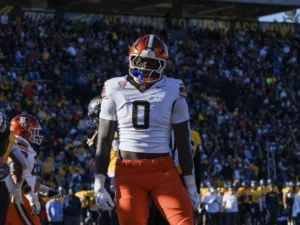
Tight Ends: Can College Yardage Help Predict NFL Success?
When evaluating talent for the NFL, analysts often look at a player’s college performance to predict their professional success. In our 64-part
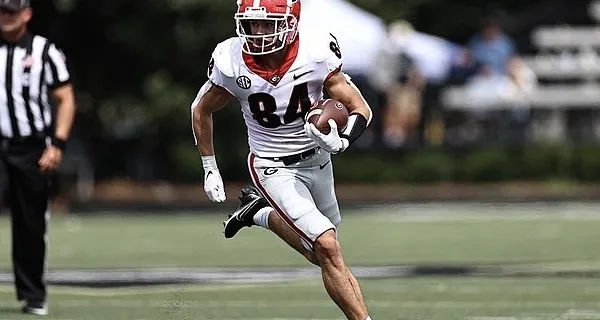
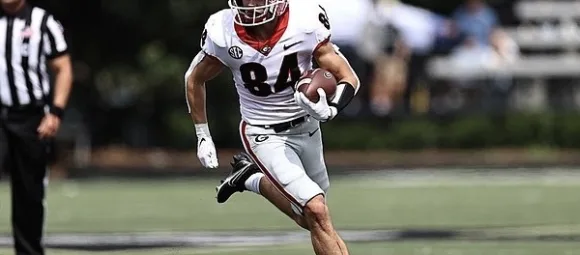
For the 66th installment of our “Does It Matter?” series, we continued our number crunching addiction to find the impacts of arm length on an NFL wide receivers performance. Traditionally, metrics such as height, weight, and speed have been the primary focus when evaluating the potential of wide receivers. Through our research and number crunching, we’ve uncovered interesting findings that could change how we evaluate wide receiver prospects. In this article we reveal the arm length threshold that signifies a higher performance level. Further, we found ten rookie WRs you might want to rethink due to their measurements.
Our research began with a simple question: Does arm length influence the performance of NFL Wide Receivers? To answer this, we collected the top 50 fantasy football finishers since 2003. We only relied on NFL Draft Combine measurements for a consistent data set.
We analyzed the data to identify trends across different performance brackets: the top 1, 5, 10, and 11-50th place finishers. From this, a promising pattern emerged: in 17 out of 21 seasons, the average arm length of the top 5 wide receivers was equal to or greater than that of wide receivers ranked 31st to 50th. This is 80.9%, suggesting that superior performers might indeed possess longer arms.
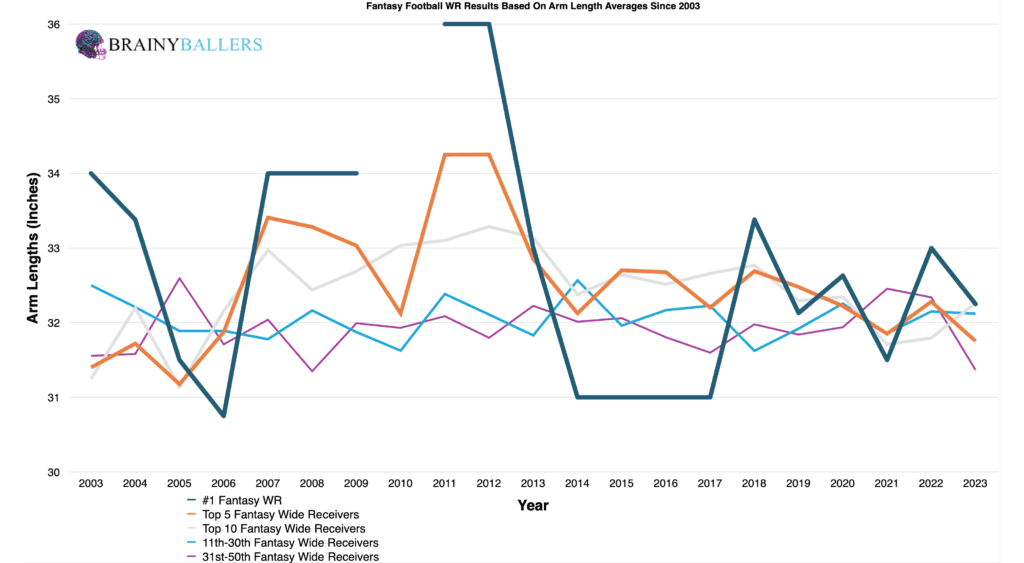
Our number crunching didn’t stop there. We plotted the arm lengths of the top 10 and bottom 10 finishers in 1/8″ increments and compared both. This comparison revealed significant performance jumps at 34″, 32.625″, and 31″ inches. This led us to believe 31 inches was a possible minimum arm length for peak performance.
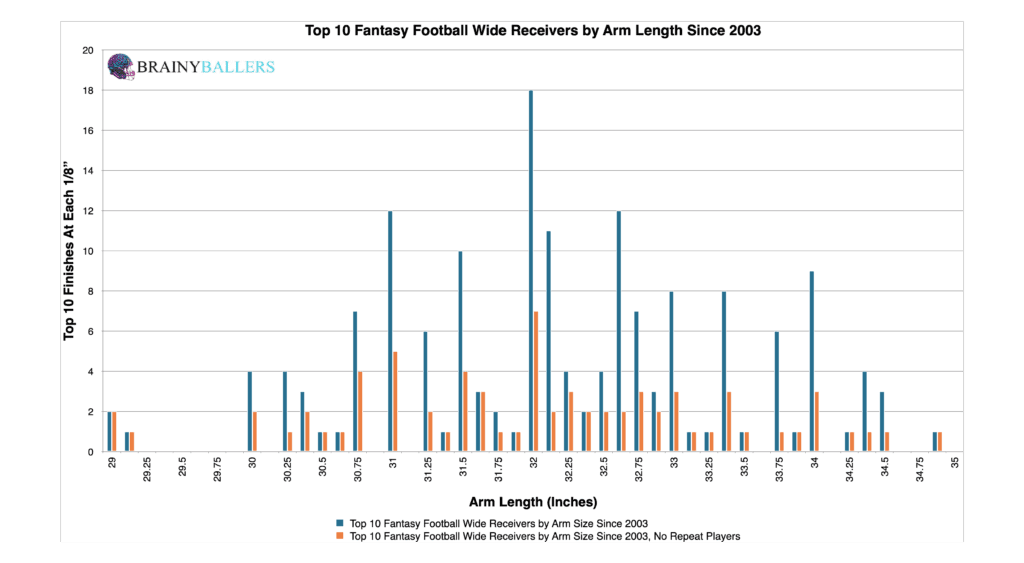
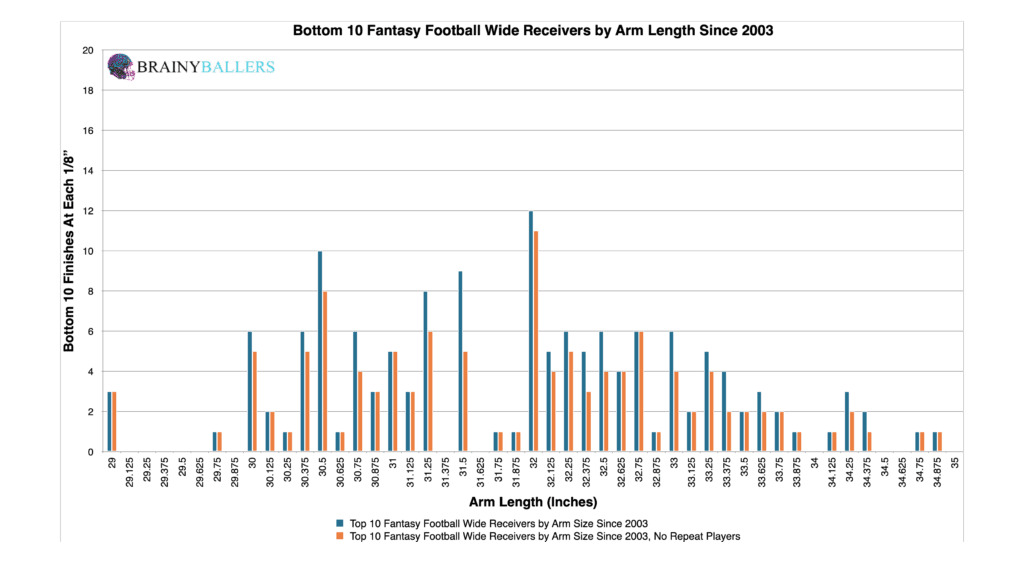
Although, we sought to pinpoint an arm length range where the most remarkable performance boosts occurred. This led to the creation of our differences chart. This compares each arm length and the next 1 inch by subtracting the results of the bottom 10 from the top 10.
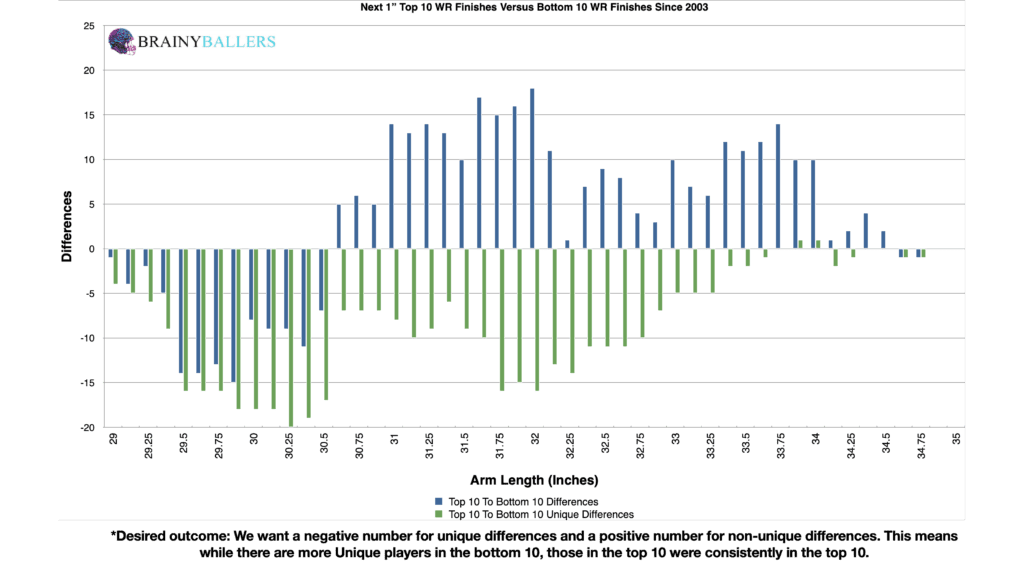
From this chart, we see a clear increase in more top 10 finishes than bottom 10 finishes beginning at 30.625″ (blue). The chart’s desired outcome is a negative number for unique differences and a positive number for non-unique differences. This increase continues throughout the remainder of the chart besides two small blips at 34.625″ and 34.75″. Further, we see a negative unique number at 30.625″ and extending throughout the remainder of the chart besides two small blips between 33.875″ and 34″ (green). This positive non unique difference coupled with a negative unique differences from the top 10 to the bottom 10 shows players who more consistently performed at a high level. Essentially, if they showed up in the top 10 once, they were more than likely to do it again. This set 30.625″ and above as the threshold, since that is when the inverted positive and negative values begins.
To further test this threshold, we compared the arm lengths of the top 10 NFL Wide Receivers to the arm lengths of receivers who ranked in the bottom 10 during the same period. Out of 146 receivers evaluated in the bottom 10, 115 had an arm length exceeding this threshold, representing 78.8%. This percentage served as a baseline to examine whether found the average NFL WR arm length, or if we found the average high performing NFL WR arm length. The findings were quite revealing. Among the receivers who finished in the top 10 from 2003 to 2023, 157 out of 172 exceeded the arm length threshold, which corresponds to 91.3%. This indicates a 12.5% increase in the prevalence of longer arm lengths among the top performers compared to those in the bottom 10!
Due to these findings, Arm lengths could play a factor in our Star-Predictor Score (SPS) model. Since 29.0″ is the smallest arm length seen since 2003 in the top 10, that will be the critical value in the SPS. The Star-Predictor Score (SPS) is a scouting tool designed to maximize investment potential and reduce risks when drafting rookies in Fantasy Football. It is proven to have a higher accuracy than draft capital alone to predict fantasy success. The SPS includes 13 to 17 metrics, with the exact number varying by the player’s position. All these metrics are pre-NFL, and some are invented by us, providing a complete analysis of a player’s analytical profiles. The SPS gained widespread notoriety for its high accuracy, having made it on Barstool and The Pat McAfee Show. The SPS can be found here.

For standard statistical methods, we calculated a Pearson Value of 0.137. This indicates significant correlation between a WR’s Arm Length and fantasy points. We are hoping for a minimum of 0.1, or an inverse correlation maximum of -0.1 when we study world-class athletes as we are. For reference to something that everyone acknowledges matters in prospect scouting, and to show the accompanying Pearson value, QB draft capital prevailed a -0.219 Pearson value.
Delving deeper, we wanted to compare decades to see if there are any recent trends supporting or nullifying this arm length threshold. Those results are seen below:
Top 10: 92.1%, 11-40th: 81.5%, Bottom 10: 81.0%
Top 10: 94.2%, 11-40th: 86.5%, Bottom 10: 76.5%
There’s a noticeable increase in the percentage of players in the top 10 and 11-40th place with arm lengths above the threshold, only further supporting the threshold’s importance.
What 3 metrics matter the most when scouting a rookie Quarterback? What threshold should Quarterbacks achieve within those metrics to be considered an elite prospect? How much should you value those stats above all other stats? Couldn't answer those questions? Rest easy, we have it handled for you. That's what this chart answers. Sort by importance and/or filter by position. Unlock by signing up with the links provided. $9.99/Year or $24.99 Lifetime access. Cancel anytime.
As seen in our recent studies, the ideal height for a wide receiver is 6’2.5” to 6’3”. Data indicated a 6.4% increase in representation among the top 10 WRs compared to those outside this top tier. Similarly, the weight range of 220-240 pounds was found. With the top 10 WRs having a 10.9% higher representation in this category over those ranking from 11th to 50th since 2003. And now we know the preferred arm length is above 30.625″, as seen by a 12.5% rate increase of this length appearing in the top 10. Arm length, as shown by the data, can be used as a talent evaluation tool when assessing NFL Wide Receivers.
Our series has always sought to push the boundaries of sports analytics, and this latest installment reaffirms our commitment to uncovering the hidden dynamics that define the game. Every Saturday We will dive deep into the most intriguing questions, bust myths, and settle debates with thorough analysis similar to this. We thrive on curiosity and welcome your input — so please, leave comments or reach out to us with topics you’re eager to see dissected next. All of our research can be found on our Analytics Page. Up next on our agenda for Part 67 of “Does It Matter?” is an examination of Tight End BMI: Does It Matter? If so, what’s the ideal BMI for NFL success? Mark your calendars; every Saturday we shed light on the topics that matter to you. All it takes is a short question and we will go to work for you!



When evaluating talent for the NFL, analysts often look at a player’s college performance to predict their professional success. In our 64-part

In our 63-part analytical series, “Does It Matter?”, we next wanted to look into the intriguing question of whether a Tight End’s
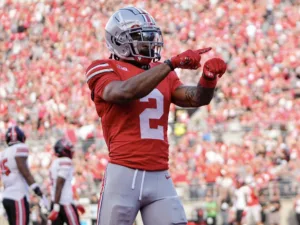
For our 61 part “Does It Matter?” series, we looked into whether a Wide Receiver’s College Yards After Catch per Reception (YAC/Rec)
© 2023 BrainyBallers | All Rights Reserved